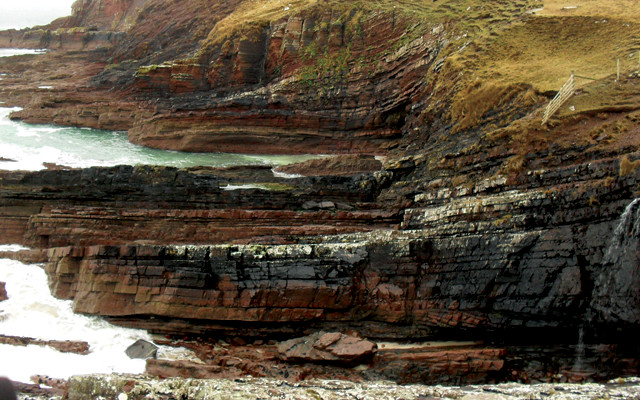
by Lucas Joel Friday, October 23, 2015

Scientists collected 1.2-billionyear- old lake sediments from this cliff at the Bay of Stoer in northwestern Scotland to measure molybdenum supply. Credit: Samuel Spinks.
All life needs nitrogen to build essential molecules like proteins, RNA and DNA. And to acquire nitrogen, cells need molybdenum. But molybdenum is thought to have been very scarce in Mesoproterozoic oceans 1.6 billion to 1 billion years ago, potentially stalling the evolution and diversification of life in this period, which was then entirely microscopic. New research, however, is revealing that lakes during this time contained relatively high levels of molybdenum, suggesting life may have continued evolving in those settings.
John Parnell of the University of Aberdeen in Scotland and his team examined 1.2-billion-year-old shale — formerly lake sediments — from Scotland to determine molybdenum levels. They found that the lake shale’s molybdenum levels were more than three times the average of shales deposited in marine settings at the same time. The ancient Scottish rocks’ fine laminations indicate a sediment burial rate of about 0.27 millimeters per year — a rate one to two orders of magnitude greater than those of marine rocks — suggesting molybdenum was consistently resupplied to the lake in which the shale formed.
Most molybdenum is supplied to oceans via continental weathering, and it appears that “lakes and other terrestrial environments are important reservoirs for molybdenum between weathering and entry to the marine environment,” Parnell and his colleagues wrote in Nature Communications. This is “consistent with evidence for a greater diversity of eukaryotes in marginal marine environments compared with offshore marine environments,” which suggests life could have thrived and evolved in such lakes more so than in the oceans, the team wrote.
© 2008-2021. All rights reserved. Any copying, redistribution or retransmission of any of the contents of this service without the expressed written permission of the American Geosciences Institute is expressly prohibited. Click here for all copyright requests.